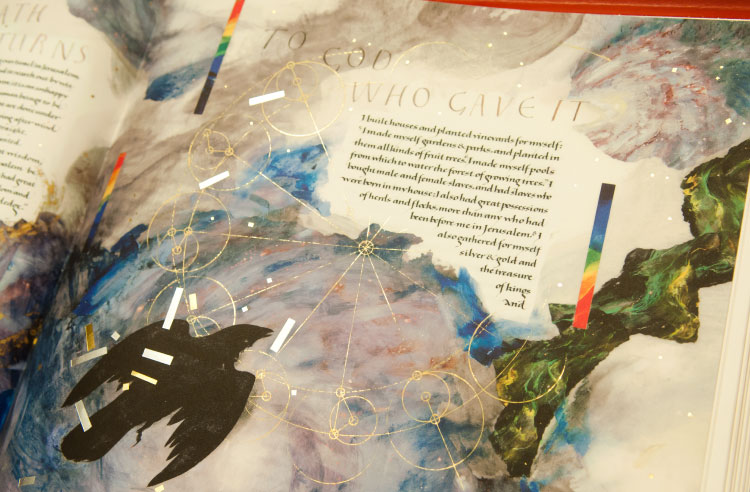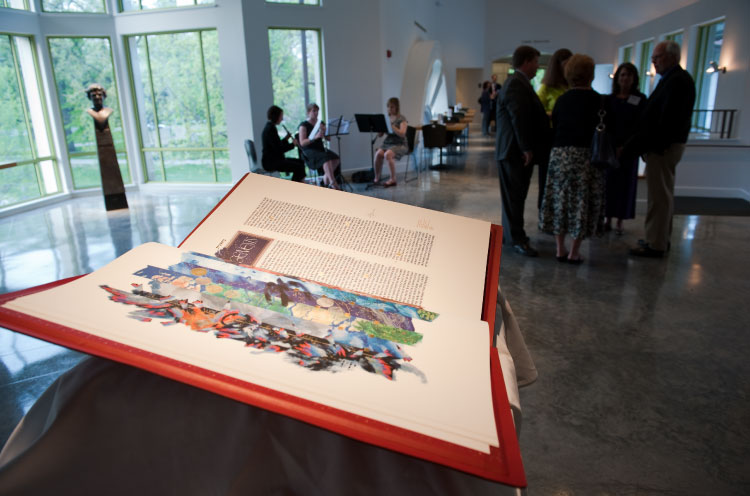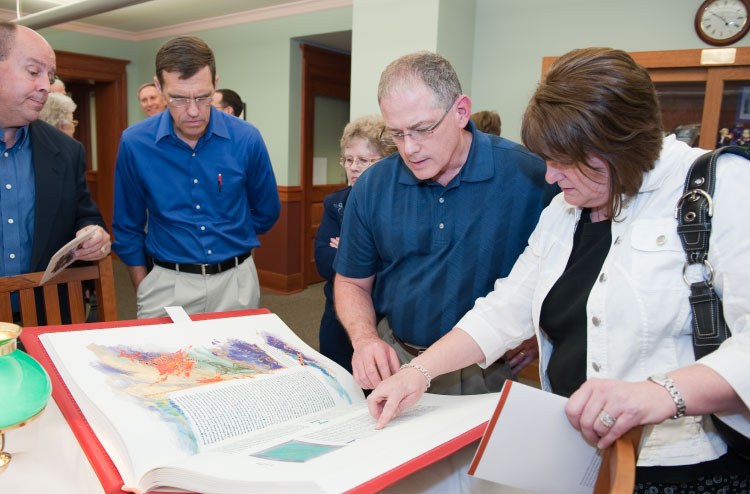In many ways, philanthropic support has been key to the university’s advancement towards the goals of K-State 2025. Thanks to the support of K-State alumni and friends, philanthropy has made a lasting impact on academic programs, facilities, residential living, and student affairs across the university community—including K-State’s approaches to Engagement, Extension, Outreach, and Service (pdf). Knowledge can be cultivated and shared in many ways, from various forms of creative endeavor to books of all shapes, sizes, and kinds.
Books and philanthropy are both powerful entities, and when interwoven together, the impact can be much greater. Just as books come in a wide array of forms, so do philanthropic deeds. Warren and Mary Lynn Staley, proud K-State alumni from Edina, Minnesota, recognized the power that can lie within pages of a book and generously donated their Heritage Edition of The Saint John's Bible to the University. It is their hope that The Saint John’s Bible would ignite conversations that take place on campus and in the community. The educational outcomes they expected to be produced by the Heritage Edition "are what breathes life into education," the Staleys said.

This page from the Saint John's Bible showcases the level of detail and some of the many artistic elements that are incorporated throughout the Heritage Edition.
Students, faculty, staff, and community members are invited to admire the work of art on display in the Morse Department of Special Collections at Hale Library. The volumes of The Heritage Edition stand 2 feet tall and 3 feet wide when opened and are a reproduction of the original, handwritten, illuminated Saint John's Bible. Beginning in 1988, Donald Jackson of Wales and a community of calligraphers, illuminators, and Benedictine monks in Central Minnesota combined their biblical scholarship and artistic ability to compose the 1,150 page handwritten Bible. Taking 12 hours just to complete the text of each page, the one-of-a-kind work of art was completed in 2011, making it the first illuminated Bible to be commissioned in 500 years.
In the spring of 2012, when the The Saint John’s Bible first arrived on campus, philanthropy helped bring to life a series of arts and culture events and engagements through an initiative called Creativity Illuminated. This partnership between K-State Libraries, the Marianna Kistler Beach Museum of Art, McCain Auditorium, and the Staley School of Leadership Studies offered four days of activities designed to foster creativity, promote academic discourse, and encourage cultural awareness on campus and in the community by exploring arts, culture, history, and more. As a signature initiative of K-State 2025 and a key area of philanthropy, Creativity Illuminated will continue to promote and highlight the creative arts as a nexus for university-wide, multidisciplinary research and discovery.

The Saint John's Bible was displayed at the Marianna Kistler Beach Museum of Art in 2012 as part of Creativity Illuminated. View more photos from the events of Creativity Illuminated, and keep an eye out for more events this spring. K-State Libraries, the Beach Museum of Art, McCain Auditorium, and the Staley School of Leadership Studies are four of the nine campus units that make up the University Programs initiative through the K-State Foundation. Learn more about how these partnerships and programs elevate the K-State experience through the Innovation and Inspiration Campaign for K-State.
Attached to the unique gift was a desire of the Staleys that it be shared with not only the K-State community but also the community-at-large. With this desire in mind, the docent volunteer program came to be. "We have a half a dozen of volunteers and staff who take requests and take volumes of the Bible out into the community," said Lori Goetsch, Dean of K-State Libraries.
With the commitment of the volunteers and staff, The Saint John’s Bible travels far and wide—from Wichita, Hays, Kansas City, and many places in between. "We have even started to track its miles to see just how far it has traveled," Goetsch said.
David Carter, a program specialist in K-State Office of Engineering Extension, has become passionately involved with the docent program and volunteers his personal time sharing his knowledge on The Saint John’s Bible with various organizations and groups. "My work ethic compels me to extensively prepare for every presentation, Carter said. "Almost every time I study for a presentation, I learn something new, whether it is from Scripture or the illuminations incorporated by Donald Jackson."

Guests at the opening of the Saint John's Bible exhibit gather around to view the text and illuminations at the Morse Department of Special Collections in Hale Library. David Carter, program specialist at the K-State Office of Engineering Extension and volunteer for the Saint John's Bible docent program, examines the detail within the work. Carter is one of the many volunteers who have brought the Saint John's Bible to communities statewide.
The Heritage Edition encompasses both modern technology and the original religious sacred text that dates back to over 1,500 years. Strands of DNA, a microscopic view of the aids virus, and satellite images of Earth are just a few of the visual elements that are incorporated.
The Heritage Edition can be leveraged as an educational tool for students, faculty, and community members desiring to further their knowledge on art, philosophy, history and religion. Carter shared that people are immediately impressed by the sheer beauty and aesthetics of The Saint John’s Bible. The spacious vellum pages are crafted of organic handmade inks, hand-ground pigments, and gold leaf.
The special book cultivates inquisitive conversations, enriches learning, and ignites creativity as individuals become immersed in the intricate detailing of the illuminations and the history that lies deep within the Scripture. By providing a space for the curation of such works and a mechanism by which those works can reach the public at large, Kansas State University serves as not only a cultivator of knowledge, but also a vehicle to serve and stimulate society by extending that knowledge beyond the borders of campus.
